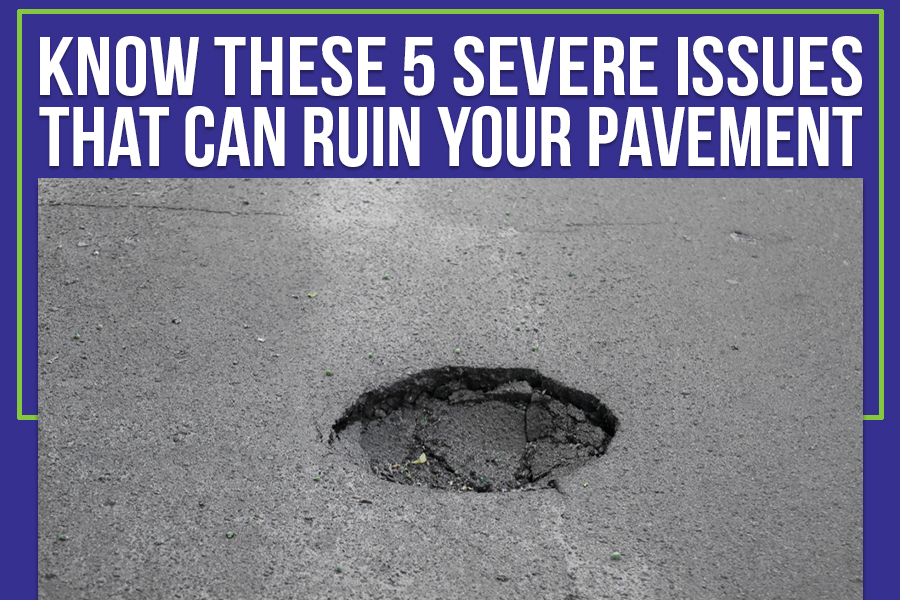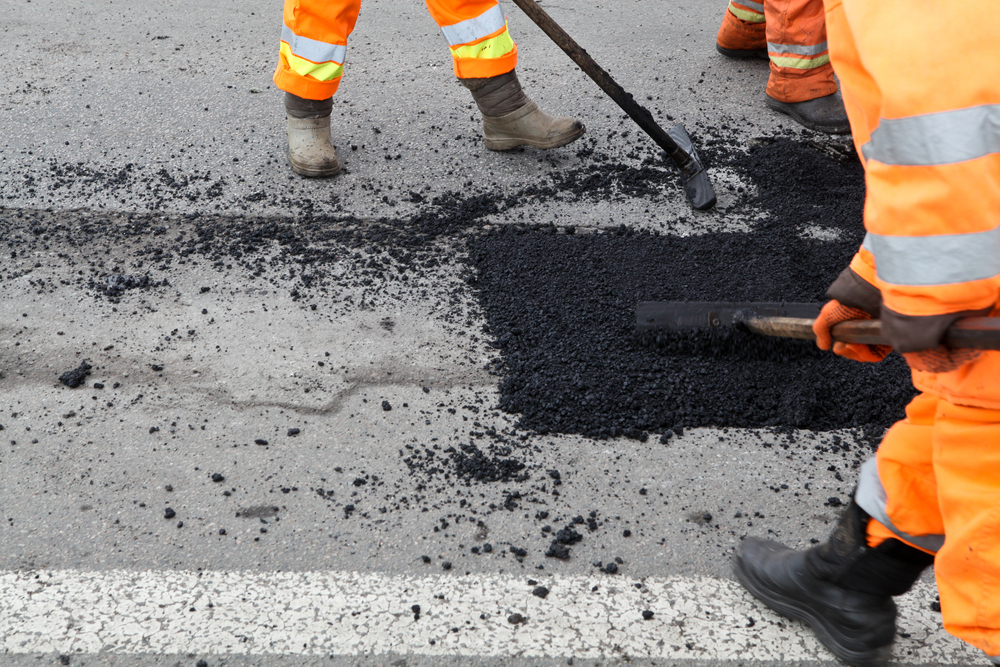
Key Takeaways:
- Asphalt pavement distress refers to any visible damage to the surface of an asphalt road or highway.
- The most common types of pavement distress include alligator (fatigue) cracking, asphalt bleeding, block cracking, potholes, and raveling.
- Alligator cracking occurs due to constant traffic load. It results in a web of interconnected cracks that resemble the backs of crocodiles or reptiles.
- Asphalt bleeding occurs during hot weather or heightened traffic, creating a glossy reflection on the pavement surface.
- Block cracking creates a patchwork of distinct rectangles on the pavement surface, and repair options depend on the extent and severity of the cracks.
Asphalt pavement is resilient but not invincible, which is why proper maintenance and repair are essential. It can succumb to various distresses, including fatigue cracking,including fatigue cracking, potholes, raveling, etc. Learning about common asphalt issues can help you effectively address and possibly prevent them.
This blog post by 309 Paving Services discusses asphalt pavement cracks and other distresses in detail.
What’s Asphalt Pavement Distress?
Before we dive into pavement cracks, let’s take a quick look at asphalt pavement distress. Asphalt pavement distress is any visible damage to the surface of an asphalt road or highway. It can include potholes, rutting, stripping, raveling, and other forms of deterioration.
Fatigue cracks occur when repeated traffic loads on a road cause it to weaken and crack. Various factors, including poor compaction, inadequate drainage, asphalt mix characteristics, or the pavement structure, generally cause it.
Types Of Pavement Distresses
1. Alligator (Fatigue) Cracking
The fatigue failure of a Hot Mix Asphalt (HMA) surface due to constant traffic load can cause a web of interconnected cracks. Longitudinal breaks begin forming in the wheel paths. With further repetition, these splits connect and morph into alligator-like shapes that resemble the backs of an alligator.
When fatigue cracks appear in asphalt pavement, it is essential to investigate the cause of failure. It involves digging a pit or coring the surface to assess its structural makeup and discerning if subsurface moisture also plays any role. Fatigue crack repairs are usually divided into two distinct sections: small, isolated cracks that result from subgrade deterioration and larger cracks indicative of structural deficiencies.
2. Asphalt Bleeding
During hot weather or heightened traffic, asphalt binder is pushed out of the aggregate voids and onto the pavement surface. It creates a glossy reflection that can become tacky when dry and slippery when wet – known as bleeding. As you cannot reverse this process during colder temperatures or periods of low loading, an accumulation of asphalt binder will rack up on the road over time.
When minor asphalt binder film is present on the pavement’s surface, you can often resolve it by applying a layer of coarse sand to soak up the extra bitumen. While this measure may reduce or eliminate the visibility of the bleeding, it won’t address any underlying issues that caused it in the first place.
To eliminate significant bleeding, a motor grader should cut away any extra asphalt, or you can use a heater planer for removal. If the outcome is an uneven surface, resurfacing may become necessary.
3. Block Cracking
Block cracking is a type of distress that occurs in an asphalt pavement when the pavement’s surface breaks into rectangular-shaped pieces. These pieces resemble large blocks. Hence the name “block cracking.”
Block cracking typically occurs due to several factors, including aging, weathering, and traffic loading. Over time, the asphalt binder that holds the aggregate together in the pavement can become brittle and lose its elasticity. This can cause the pavement to crack and break into blocks under the repeated weight of passing vehicles.
Regarding block crack repairs, your approach depends on how severe and extensive they are. If cracks measure less than half an inch wide, utilize a crack sealant to stop moisture from entering the subgrade and protect them against fraying of their edges. As long as these minor cracks remain sealed, Hot Mix Asphalt can last years without further work. However, if appearance is important or widespread cracking is present, consider applying an additional slurry seal over already-sealed cracks for maximum protection.

4. Potholes
Potholes are a common road defect caused by the erosion of asphalt pavement due to water infiltration, vehicle traffic, or other factors. They typically appear as shallow depressions in the roadway ranging from just a few millimeters to several feet deep. Potholes can cause damage to vehicles, bicycles, and pedestrians if left unchecked.
To repair, fill the pothole with hot mix asphalt (HMA) or cold mix asphalt (CMA). HMA is preferred for larger potholes or areas with heavy traffic, while CMA is suitable for smaller potholes and areas with light traffic. Compact the asphalt with a vibratory roller or plate compactor to ensure a smooth surface.
Related: How Can Potholes Pose a Serious Road Hazard?
5. Raveling
Raveling is the progressively destructive disintegration of an HMA layer from the surface downward caused by dislodged aggregate particles, creating hazardous conditions for drivers. Loose debris on the road, roughened surfaces, and water pooling in raveled areas can lead to vehicles hydroplaning, decreased skid resistance, and an unsafe driving environment.
When repairing a raveled asphalt pavement, the first step is always to analyze what caused the failure. Most repair solutions can be divided into two distinct categories:
- When dealing with smaller areas of raveling, you’ll want to remove any debris before patching and sealant coatings, such as fog or slurry sealing, if necessary.
- Removal and overlay will likely provide better results if larger sections have become severely damaged due to asphalt deterioration.
Exceptional Asphalt Maintenance and Repair Services in Peoria, IL.
With over a decade & a half of experience in the asphalt paving industry, 309 Paving Services is proud to call its customers friends! We are your go-to experts for all things related to asphalt paving – from repairs and installations to sealcoating and striping in Peoria, IL.
Our free estimates will give you the information you need to make an informed decision. Get in touch today and begin your path toward a successful paving venture!


